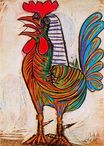©Пабло Пикассо - Плачущая женщина 1937
 |
 |
 |
 |
 |
 |
 |

Плачущая женщина 1937
55x46см холст/масло
National Gallery of Victoria, Melbourne
The image is only being used for informational and educational purposes
<< Previous G a l l e r y Next >>
From National Gallery of Victoria, Melbourne:
This striking painting of a woman holding a handkerchief to her tear-stained face, is one of a series of images of weeping women that Picasso produced in 1937, which were intended to stand as mute visual witnesses to a shameful modern tragedy.
In January 1937 Picasso had been asked by representatives of the Spanish Republican government to paint an enormous mural for the Spanish Pavilion at the Paris International Exhibition in the coming summer. On 26 April 1937, while Picasso was at work on this commission, German planes – acting in concert with General Francisco Franco – bombed the Basque city of Guernica for three hours, levelling it to the ground. Picasso’s shock at this massacre of defenceless Spanish civilians led him to declare, in a statement published in the Springfield Republican on 18 July 1937: ‘In the panel on which I am working, which I shall call Guernica, and in all my recent works of art, I clearly express my abhorrence of the military caste which has sunk Spain in an ocean of pain and death’.
The Weeping women compositions of late 1937 belong to what have been termed the ‘postscripts’ of Picasso’s famous painting Guernica. The common stark motif in these disturbing images, that of a woman’s grief laid bare for public scrutiny, derived from the figure at the far left of the Guernica mural – a woman who screams uncontrollably and attempts vainly to escape the bombing, grasping her dead child to her chest. Aspects of Picasso’s turbulent love life have also been read into Weeping woman – a complex web of relationships involving his former wife Olga Koklova, and concurrent new lovers Marie-Thérèse Walter and Dora Maar.